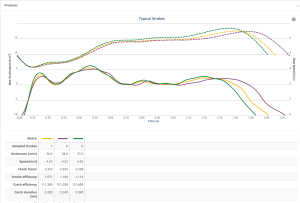I had RIM running in the boat today (as usual) and since I haven’t rowed at these high rates before, I decided to take a look at the stroke accelerations and see what flaws I could see. Turns out they are readily apparent.
First, for comparison, here are some nice steady state strokes at 23 and 24 spm.
See that nice smooth drive at 23 SPM (purple). Then as the rate goes up to 24, you can start to see the appearance of the double hump in the drive. That’s is me opening my back early.
Next, here are 3 sets of strokes when I was trying to hit targets of 26, 28 and 30. They actual rates were a bit higher. I guess I was over eager.
The double hump continues to be more pronounced and you can begin to see two other flaws. First is a disturbance at the finish (around 0.8sec). That is me starting to get sloppy as I try to get back up the slide more quickly. The other is a gradual rise in acceleration during the recovery (starts at 1.2sec at r30). But still, not horrible.
Now we look at r34 and r36. These are a bit harder on the eyes.
The double hump is now significantly more offensive, there is a pronounced blip at the finish and I am clearly accelerating as I move up the slide versus maintaining a steady speed from the handles all the way through the legs on recovery. The miracle here is that I actually rowed at these rates at all.
Lastly the ugliest of the bunch. Here are three blocks of strokes at 38 to 40 spm.
Same flaws as before, only more pronounced. It appears that going from 38 to 40spm does not enable me to make the boat go any faster. In fact, now the double dip is so pronounced that acceleration goes almost all the way down to zero in the middle of the drive.
So, what to work on. I need to work on not opening my back. I think the prescription is a set of 20 stroke intervals between 30 and 36 spm with enough paddle time so that I am working on technique instead of fitness. This will get into the program next week after the race.







